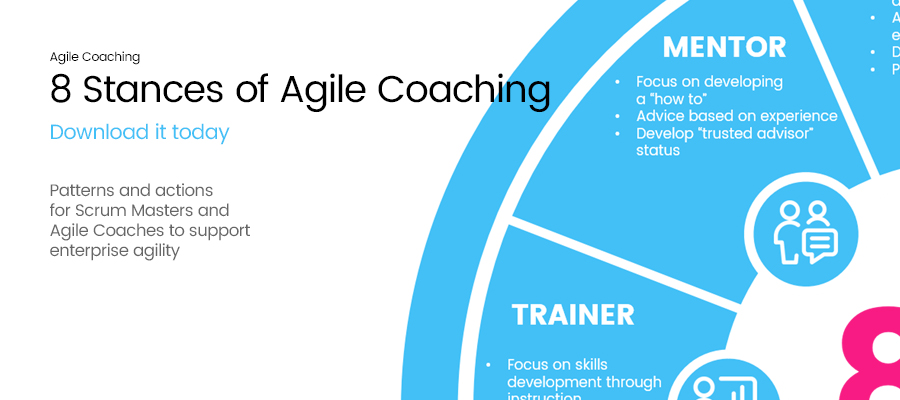
The role of Agile Coach is growing in prominence in many organisations. From software development through to marketing and HR, whole organisations are now seeing benefits from agile adaptive approach to work, and are building internal positions for new Agile Coach roles, but is this the right approach?
The Scrum Master and Agile Coaching
According to the Scrum Guide [1], a Scrum Master has three key areas of accountability [1]:
- Coaching teams by promoting cross-functionality and helping them to self-manage and self-organise within guardrails set by executive.
- Coaching the Product Owner in agile product management techniques for effective Product Goal definition and Product Backlog management.
- Coaching the organisaton by leading, training and leading the enterprise in agile adoption, particularly where Scrum is concerned.
Overall, the Scrum Master role is a coaching role with many aspects covering teams, the product owner and supporting stakeholders and the wider organisation. When all of these aspects combine enterprise agility increases. This is no small feat, though, and requires years of experience, practical experience, and business acumen, to do effectively at all levels of the organisation.
Most organisations' Scrum Masters don't do agile coaching
Job advertisements globally, though, reflect a different picture of the Scrum Master, one that tends to focus on a range of project management related activities including managing scope, technical delivery, reporting, even managing JIRA task boards. Unfortunately, this means most Scrum Masters don't have formal agile coaching responsibilities. As such, they're probably not focussed on agile coaching but something else.
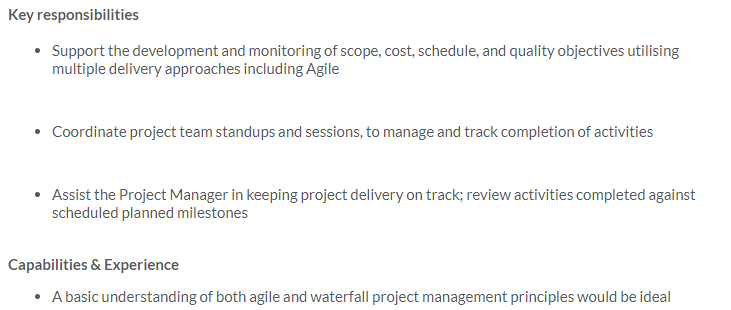

The Hidden Cost for Business Agility
Getting agile governance right -- from a Scrum Master's responsibilities for coaching through to the Product Owners accountability for value, budget, and delivery -- isn't easy. Moreover, when legacy roles are used to define what a Scrum Master does, and when they're not held accountable for agile effectiveness or given the responsibility to address agile capability maturity through coaching others, legacy roles have unintended consequences.
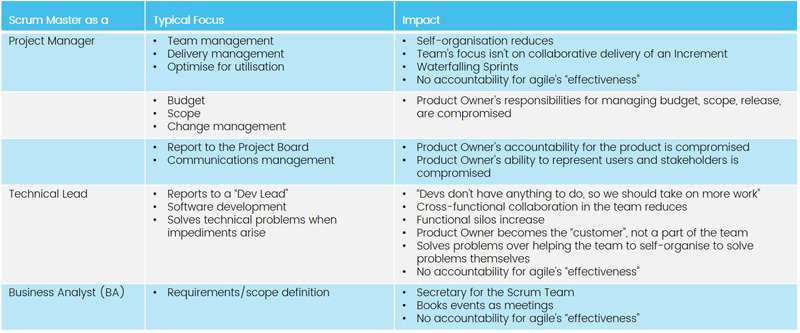
I've personally seen many organisations implement the Scrum Master role as a part-time task attached to a senior software developer's responsibilities. When this occurs, the person still reported to a Dev Manager, and so was only rewarded for their software development, not how effective they were at coaching the team to be self-managing and cross-functional. This resulted in:
- Teams doing "mechanical" Scrum.
- When User Stories' coding was completed then developers "pulled" more from the Product Backlog over supporting the rest of the team to get items to Done.
- Rolling their sleeves up to solve coding problems over coaching the team to self-manage and solve the problem themselves.
- Resolving conflicts and removing obstacles for the team to avoid delivery issues rather than coaching the team to resolve the issues for themselves.
I've even had a Scrum Master present at Scrum of Scrums claiming his developers have run out of work to do. I responded by asking "is all the work Done yet?" and reminding him that this was his problem to solve - to support his whole team to understand how to work in a cross-functional way over only working in their dev/test silos.
Ultimately, addressing an enterprise capability gap by creating specialist Agile Coach roles doesn't fix the governance problem. It only creates an additional layers of bureaucracy that turn Scrum Masters into a junior role instead of an agile management and leadership role. It reinforces Scrum Masters position in software team management instead of addressing how to make effective use of it's core purpose: make Scrum effective through coaching teams, stakeholders and Product Owners.
How to Fix the Problem: Getting Scrum Masters to be Agile Coaches
Evolve your governance
Understanding that Product Management requires different governance is key to putting in place effective roles and responsibilities for Scrum Masters who can coach the enterprise to make the best use of agile.
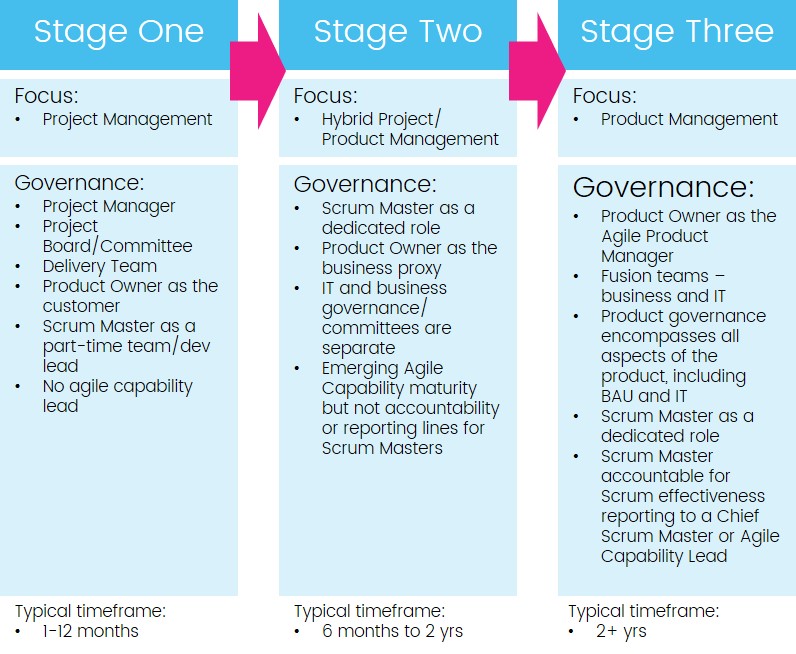
Many organisations begin their agile transformation journey with looking at their IT project management processes. They stick with their control gates and governance and place "agile" into the delivery stage. From there, they start move out of a hybrid Water-Scrum-Fall process into dedicated, long-lived teams, business involvement and managing delivery through backlogs instead of gantt charts. A Scrum Master's coaching activities are a key catalyst to this evolution, leveraging their knowledge of Scrum theory and practice to help their stakeholders, teams and managers create an environment of empiricism and iterative planning and delivery.
When evolving the governance, be mindful though of the "Proxy Product Owner" trap. Until business stakeholders see value in participating in agile as "partners" and "fusion teams", they'll likely delegate the Product Owner role to the lowest possible level, turning it into little more than a messenger for requirements management, acceptance and sign-off. It may be more effective to have the Product Owner role in IT, demonstrate how it works, and the commitment that's requred to make it effective, and then transition the role to willing partipants in business areas. This also gives Scrum Masters the opportunity to:
- Coach IT-based Product Owners and build good agile product management expertise internally.
- Coach business stakeholders to raise awareness of how Scrum works, particularly at scale.
- Support the transition of business into their Product Owner role.
Grow your own Agile Coaches by evolving your Scrum Masters
As the organisation's governance evolves, and business stakeholders become more engaged, the enterprise agile environment will become more complex and the Scrum Master's role more challenging. Scrum Masters will need assistance to learn a set of contingency-based stances to apply in different circumstances, each based on:
- Reading the environment - what are its needs?
- Optimising for the whole - understanding that creating an optimum outcome for one team may not serve other teams or align to the organisation's needs?
- Supporting growth - so that teams' strengthening agile behaviours and actions creates an improved ability to pivot to disruptive change.
- Building consistency - ensuring terminology, practices, tools and processes are aligned to industry best practice?
Improve awareness of coaching stances: The 8 Elements of Agile Coaching
ZXM produced a framework some years ago to help Scrum Masters and their organisations understand the types and numbers of role types they have as an agile coach. These 8 elements of agile coaching help depict the essential stances Scrum Masters should learn to utilise:
- Trainer - Focusing on skills development through formal instruction.
- Mentor - Advising people based on experience and building professional relationships.
- Consultant - Developing frameworks and toolkits, diagnosis of issues and solving problems based on their own skills and expertise.
- Coach - Developing shared goals by focussing on changing mindsets, actions and behaviours.
- Counsellor - Helping to manage dysfunction and conflict.
- Change agent - Developing formal paths for change and assisting in agile organisational design.
- Facilitator - Helping people deliver formal outcomes without giving advice and remaining independent.
- Lean Leader - Developing people through promoting life-long learning.
Download the 8 Elements Poster
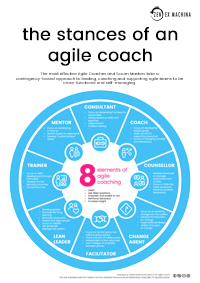
You can download the 8 Elements of Agile Coaching from the Zen Ex Machina website today for free.
Conclusions
Scrum Masters were designed by Sutherland and Schwaber to be the agile coaches of teams, Product Owners, and the wider organisation. Unfortunately, few organisations implement the role in this way. When they seek to transform their business, they often create separate Agile Coach roles. While this creates an instant capability, it can often leave an inefficient and ineffective legacy governance unchanged and a vital capability untapped - the Scrum Master. To successfully transition to agile product management, and away from project management, consider how to make Scrum Masters the agile coaches of the enterprise instead.
About Zen Ex Machina
Zen Ex Machina is an enterprise agile consultancy specialising in agile transformation. Our mission is to improve the work lives of 1m executives and teams by 2025. Zen Ex Machina's enterprise app, Agile IQ, assesses business agility, reports on coaching activities and helps grow the strength of agile actions and behaviours. Download it today at: agileiq.com.
- - -
References
1. Schwaber, K. & Sutherland, J. (2020) The Scrum Guide. The Definitive Guide to Scrum: The Rules of the Game. Online at: https://www.scrum.org/resources/scrum-guide
